October 2014
A possible portrait of Nicholas Lanier
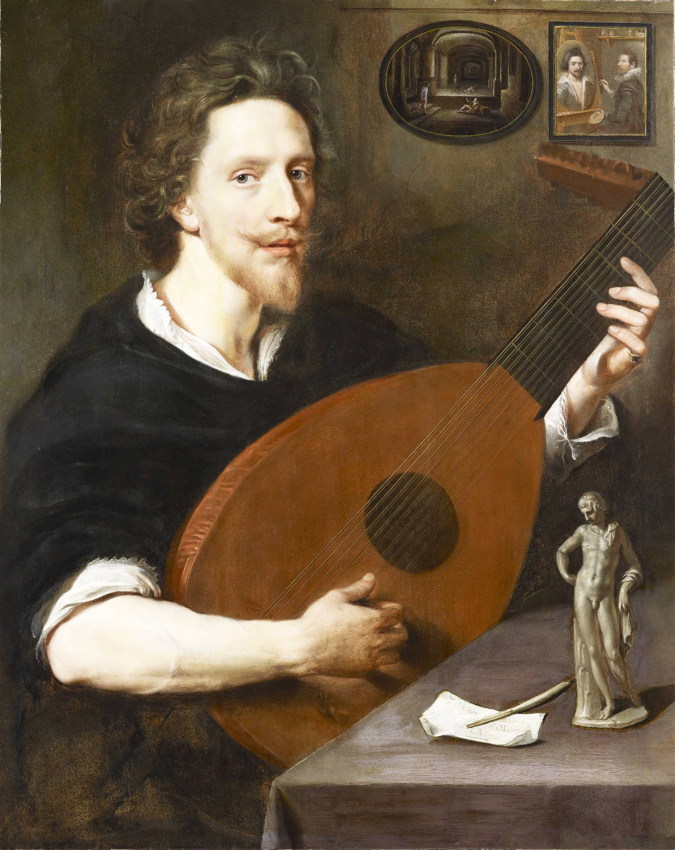
Anglo-Flemish School, not later than 1613
Portrait of a gentleman, possibly Nicholas Lanier (1588-1666),
oil on canvas, transferred from panel, 31.4 x 67.6 cm.
But maybe they had some evidence for this? After all the neck in the present version is rather short, with only 7 tied frets and no body frets. Only three years before, in 1610, Dowland had written: “the necks of lutes were lengthned, and thereby increased two frets more, so as all those Lutes which are most receiued and disired, are of tenne frets.” Surely Lanier of all people would have had an up-to-date lute? He was the rising star of English lute players and was appointed one of the lutes in the King’s Music in 1615/16 and went on to be appointed Master of the King’s Music in 1626. The pegbox itself is clearly not correct in perspective with the neck even though the perspective in the rest of the picture is well handled. Were there still existing at that stage traces of this longer neck and did the first restorers think that the pegbox was a later addition? We shall now never know. But they did at least continue the neck consistently with the lower section, with its wide gap between the edge of the fingerboard and the topmost visible string.
Which raises the strong question, so interesting for us now, was there a top string which is now missing? Was Lanier playing a ten-course or a nine-course lute? The gap in the lower original parts of the painting is consistent all the way: down the fingerboard, across the rose (which is otherwise very eccentric to the stringband) and, as argued below by Peter Trent, in the playing positions of the hands. Everything points to a missing top string, but we are in the hands of successive restorers and because of the restorations we cannot now re-examine this evidence and look for the missing string.
In a report on the restoration in the lavish booklet published by the Weiss Gallery who own the painting, the restorers comment that there might have been a rose design in an intermediate layer of paint now lost, but don’t really explain how this could have vanished while still leaving the overpainted strings visible. But certainly the absence of rose design is odd if indeed it is a painting comissioned by Lanier who was himself also a painter (his self-portrait hangs in the Oxford Music School) and a rising art connoiseur who was later employed by king Charles I to purchase a very important collection belonging to the Dukes of Mantua.
However if all fingers are not in contact with the string i.e. the 3
Because all of the chord is within the cross stop the tablature position is entirely moveable. Visually a much longer neck seems to make the peg box join increasingly awkward. At a stretch it is probably not going to be more than one fret higher i.e. a longer neck 8/9 frets with the first finger L.H. covering the fourth fret. This would place the example above in B minor (assuming a G tuning)
and as before, if the 3
which is a chord of Bb minor 7
As it stands there are no easy solutions to the questions raised. Was it a ten course lute, was the neck longer, has the pegbox been altered, was there a rose design? The evidence is conflicting and there is no way now to address the problem further.
This is exactly the sort of dilemma which early music has grappled with from the beginning in all its aspects. Here, the desire to make an attractive, saleable, painting out of a damaged historic relic has destroyed some of the historic authenticity which drives people to galleries rather than to reproductions. Paintings from the past are genuinely icons, revered because those are the very brush-strokes of the original artist. Similarly, when instruments are “restored” to any degree, the visiting public may be pleased, but they may also be misled. Thus the eight-course lute by Michielle Harton in Nürnberg (MI 56) is only an eight-course because of decisions made by Friedemann Hellwig in his restoration as detailed in the Galpin Society Journal XXIII (1970). It looks lovely and is plausible, but at one stage it had been a theorbo. Everything above the neck-block is now new and we can no longer re-visit the evidence for ourselves.
This painting raises interesting questions analogous to those which players, editors, makers and listeners to early music have faced for years, so we may be in a good position to comment on this aspect of art history. It is a problem of modern taste and authenticity. For this painting, which looks so beautiful now, has been much restored.
When it emerged into modern consciousness in the 1970’s this picture was in a dreadful state. Painted on three oak panels, whole areas of paint had flaked off where the panels were joined and about 3cm in from both sides of the painting. In the 1970’s it was taken off the wood panels, put onto new canvas and the missing areas were painted in. Inevitably decisions had to be made about what was in the missing parts and some rather odd choices were made. A bit later it was suggested that the sitter might be Nicholas Lanier and that it was therefore an important painting. The artist was, and still is, unknown but, from the composition and the particular flesh tones so reminiscent of Rubens, it seems likely to have been an Antwerp or at least a Flemish painter. This was the state of things when it was sold at Christies in July 2009. A very detailed zoomable photograph of it is still available on Christie’s website http://tinyurl.com/yhou3o2 It is worth comparing this with the painting as it now appears.
The main important areas of repaired damage are down the central sections of both the little wall paintings and down the right-hand-side of the painting. All the fingerboard above the sitter’s left hand was missing. For some reason the 1970’s restorers decided to extend the fingerboard and strings to the edge of the picture, completely bypassing the pegbox!
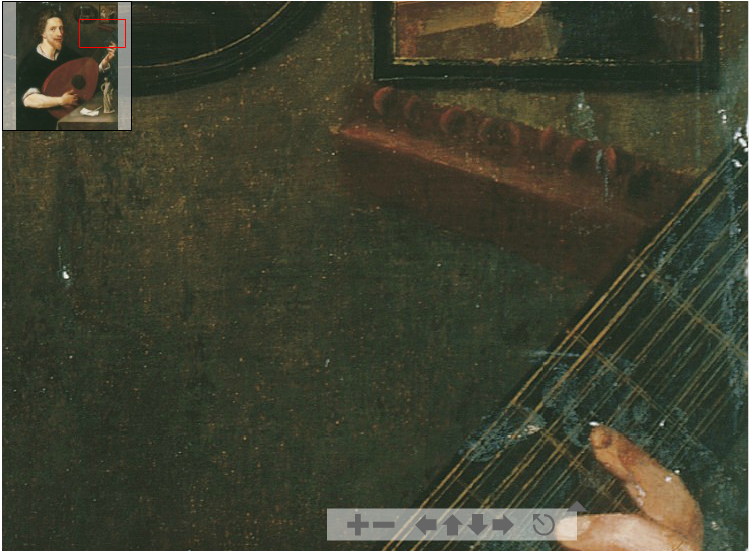
detail from Christies website
After its sale at Christies the picture went into another restoration workshop where all the old overpainting was removed (and maybe also some original final glazes, for the flesh tones no longer look so Flemish) and different decisions were made. This time the neck was finished off with an implausibly sharp, narrow-looking ebony nut in line with the pegbox and the fingerboard was narrowed above the hand to remove the awkward gap between the top-string and the fingerboard edge. The neck now has a step in it underneath the hand!
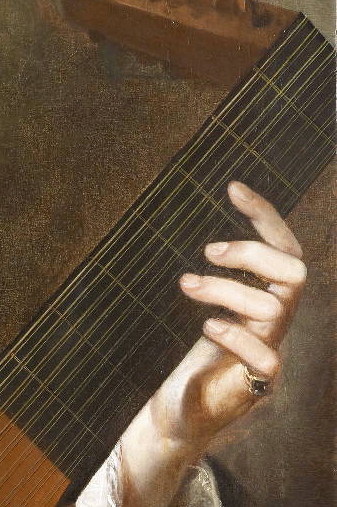
detail from the latest restoration
Of course there is also the matter of the nine pegs visible in the pegbox; most ten course lutes would normally show ten pegs on the bass side of the pegbox, so the nine double courses are a possible fit for the pegbox, but the restorers do comment on the pentimenti around the pegbox and it appears to me that a longer pegbox was at least possible. But of course some ten course lutes had a treble rider for the top string. This would have been outside the picture frame anyway and, taken together with the nine pegs we do see on the bass side of the pegbox, would have resulted in a ten course lute.
I would also argue that, at this date in England, the double top course now shown by the restorers’ decisions would have been unusual for a nine-course lute. The classic example from the period is the 9 course Buechenberg in Edinburgh which has a single top string; though interestingly that lute too has problems of restoration analogous to those presented by this painting.
Similar problems are raised by the repainting of the damage in the two little inset paintings. The damage down the centre of the rectangular picture has meant that the two different restorers have come to different conclusions about the direction of the gaze of the little artist, either towards his painting or outward towards the viewer, which makes for very different interpretations in the iconography. By choosing to show the little painter looking towards the viewer it can more plausibly be suggested that this is Lanier himself in his role as painter adding his own picture to the larger portrait of himself. They’ve even changed the size and shape of the picture. In the case of the oval picture, which all agree to be by Steenwijk and not the artist of the main picture, the restorers have differed on the number of steps in the dungeon and the shape of the main pillar.
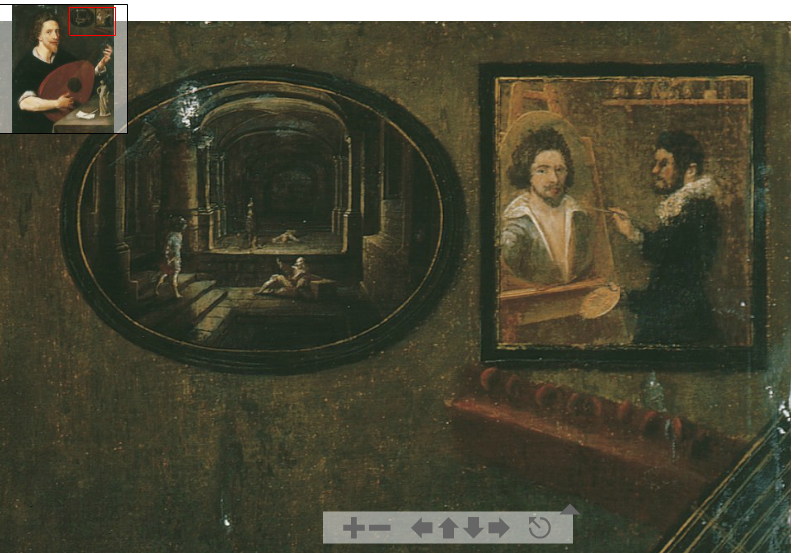
detail from Christie's showing the first restoration
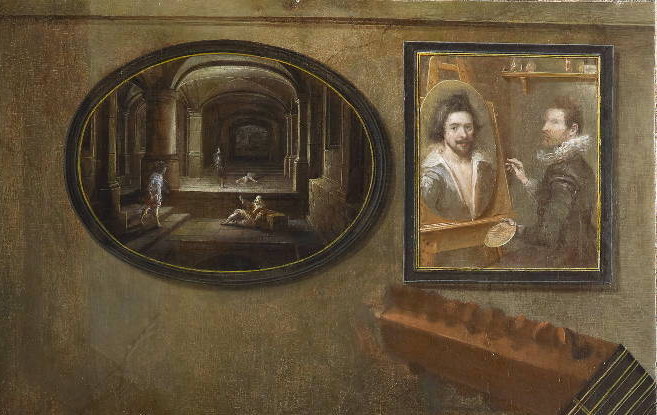
detail from the latest restoration
Another aspect of the lute which is surprising is the absence of any edging to the soundboard. Particularly as he is shown playing with the edge resting against the table as described by Mace: “And then keep your Lute stiff, and strongly set with its lower Edge against the Table-Edge,….”. This will damage an unedged soundboard quite quickly.
I have asked Peter Trent to comment on the playing position of the hands in relation to the nine or ten course question and the length of the fingerboard. He writes:
“The right hand seems to clearly be striking strings from the 5th course upwards towards the 1st (missing ) course.
This is entirely in accordance with the left hand cross stop with the first finger covering all top 6 courses on the fingerboard.
In the following tablature examples the first chord is an interpretation of what is shown, followed by a postulation of where in the course of a piece of music of the period the music might logically continue:
Assuming that the picture is showing 7/8 frets on the neck, the first chord is perfectly feasible assuming all fingers are in contact with the string and the index finger covering the 3rd fret. The f would then be making a suspension that could idiomatically be resolved in at least either of these two ways:


If it were a 9/10 fret neck then we would be in C minor a sonorous and rich key for the 10 course lute in G Renaissance tuning, but faced with a peg box that was completely out of alignment, and that might require a serious bit of overpainting to fit that theory, which is of course out of the question!
The editorial reduction to 9 double courses means the left hand index finger cross stop only covers 5 courses constituting an incorrect/amateur technique. The right hand is playing as in the original but editorially must be playing the top four courses only.
The left hand fingers still produce a chord of identifiable harmony but of a rather more unidiomatic nature. As before the examples are first with all fingers stopped except the 4

Similarly performances of medieval music often involve editorial “reconstructions” of very sparse original material which may entertain more than they inform. Of course this is legitimate and no original has been damaged. It is also entirely legitimate for restorations to be made to privately owned instruments in order to make them playable, but there is of course then a fine line between saying you are hearing the sound of the original instrument and the sound created by the decisions of a modern maker.
But for instruments in museums, editions by scholarly publishers and paintings in public galleries we do hope for a bit more restraint. If a case is made for this painting to be bought by a public institution, such as the National Portrait Gallery, it does need to be displayed with some sort of caveat about the extent of the re-working. I hope at least that detailed record photos have been taken at every stage of the restoration and would be made available so that scholars down the line will not be misled.
Copyright: David Van Edwards, Norwich 2014